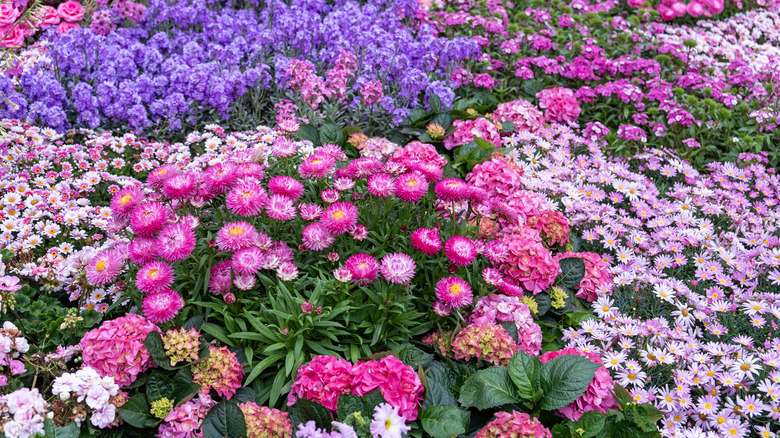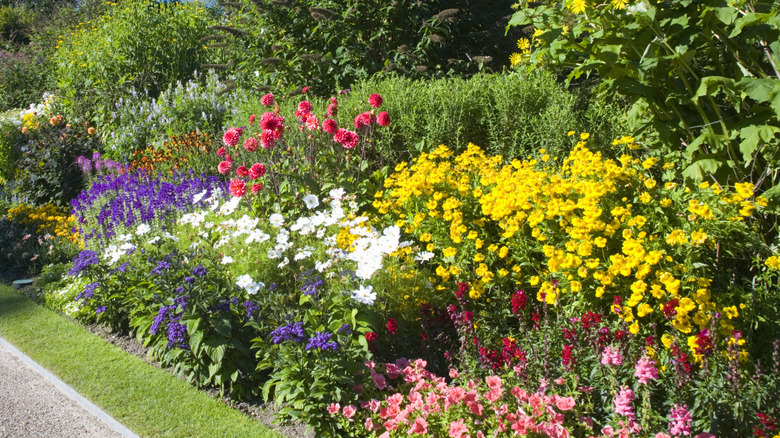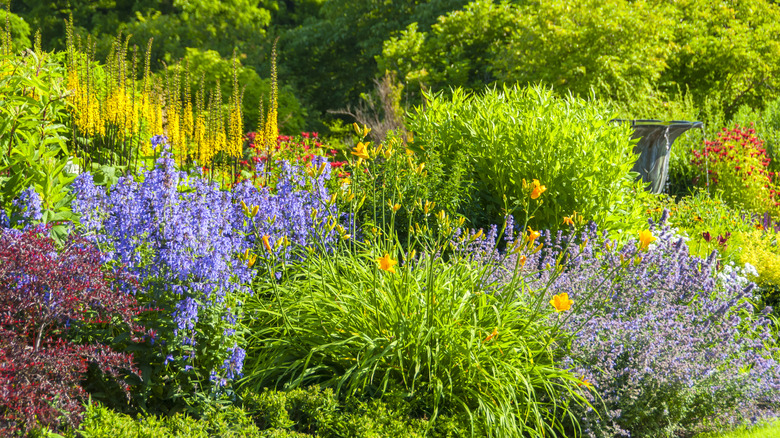How To Use Color Blocking To Design Gardens
There are a number of elements involved in designing a garden, especially when it comes to plants. In addition to choosing plants that are appropriate for a given location's growing conditions (sun, soil, etc.), you might also select them for their size, shape, texture, or color. Garden color palettes are a very important consideration for gardeners, and many people design an entire garden around specific colors. One garden design technique that can be easily utilized for dynamic, dramatic effect is color blocking.
In the world of interior design, color blocking refers to a common design trick that incorporates using solid colors in "blocks" (i.e. large areas) including more than one object. For example, a cobalt blue sofa with indigo blue cushions and a navy blue ottoman is an example of color blocking, using dark shades of blue to create a striking focal point in the room. These color blocks draw the eye and can add energy and visual excitement to a room. This same principle can be applied to garden design.
This approach to garden design was first pioneered by the legendary English gardener Gertrude Jekyll, who referred to it as planting with "drifts" of color — that is, long rectangular sections within large flower beds (usually called "herbaceous borders" in England). Jekyll's writings on gardening included sketches of visual plans and designs, and she frequently incorporated color as a primary design consideration. This innovative and creative technique of designing with "drifts" of color has influenced many gardeners and horticulturists, and provides an easy-to-use template for the modern gardener.
How to use color blocking in a garden
There are several ways to incorporate color blocking into your garden design. One approach is to plant large sections of one variety (like coneflowers, peonies, or phlox), repeating this several times along the length of the garden. This is a good approach if you have flowering perennials, as they increase in size these blocks will fill in nicely, and when you divide them you can place them elsewhere in the garden to continue the effect.
You can also combine similarly colored cultivars of one plant variety. This works well for seasonal spots of color, with pink hues of yarrow in summer, or various purple asters in autumn, or a variety of yellow tulips in spring. Plan for what will bloom after spring-blooming bulbs fade. Try planting day lilies in front of daffodils or hyacinths, so their emerging growth hide the fading spring foliage, or you can fill in with some annuals.
Further, entire sections of the garden can be planted in one color with a variety of plant shapes and textures. Try planting colorful blooms in succession to create a rainbow or spectrum effect. Unlike color blocking with interior design, where it's not recommended to use more than three colors, in a garden, color blocking works well with many assorted colors. So don't worry that it might look too busy. It's not so much about the colors themselves as it is their placement and the overall visual effect. The trick is to create a dynamic arrangement of color that delights the eye in all directions, so you're only limited by your imagination (and, to some extent, your climate).
Plant varieties that work well for color blocking
Planting annuals is an easy and convenient idea for a stunning flower garden that incorporates color blocking, especially at the front of the border where you want lower-growing plants. Well-chosen annuals can really accentuate your flowering perennials and keep the seasonal color going longer. Some of my favorite sun-loving annuals for color blocking are petunias, verbena, lobelia, and dianthus. Impatiens and wax begonias are good for shady spots, as well as foliage stunners like caladiums and coleus.
Gertrude Jekyll utilized her vast knowledge of perennial plants and their bloom times to incorporate color through the seasons. Perennials with long bloom times work best for color blocking: try columbines, peonies, and woodland phlox in spring. For summer, you can't beat clumps of flowering catmint, threadleaf coreopsis, cranesbill geraniums, veronica, foxtail lilies, day lilies, and 'Knock Out' roses. Late summer to autumn blooming powerhouses include tall phlox, coneflowers, asters, chrysanthemums, and sedums. Hostas in striking solid colors like pale blue (try 'Halcyon' or 'Canadian Blue') and chartreuse ('Fire Island' or 'August Moon') work great for shady areas and stay vibrant through late autumn.
Also, don't ignore the possibility of foliage color. Easy-care coral bells (heuchera) come in a rainbow of foliage colors (I love apricot-dusty red 'Georgia Peach' and deep purple 'Wild Rose'). Blue foliage (like junipers, sea holly, or 'Blue Zinger' sedge grass) look fresh and lively in the garden. Plants with silver foliage such as artemisia, lamb's ear, or dusty miller, add dramatic contrast to almost any color palette. Further, some deciduous shrubs have brilliant autumn hues for dramatic color potential, like oakleaf hydrangeas, ninebark shrubs, or the 'Orange Rocket' dwarf barberry.


